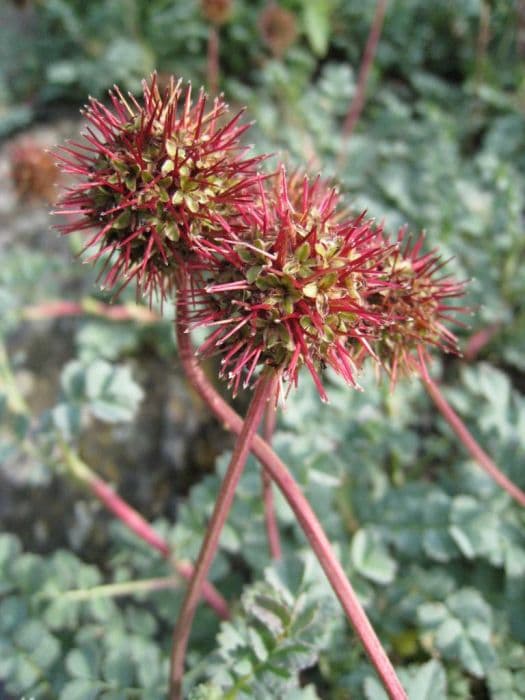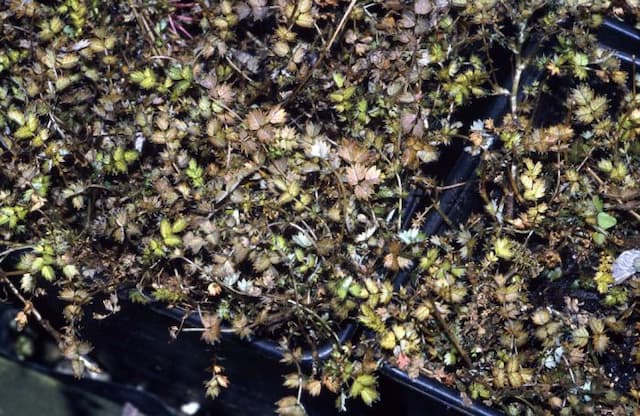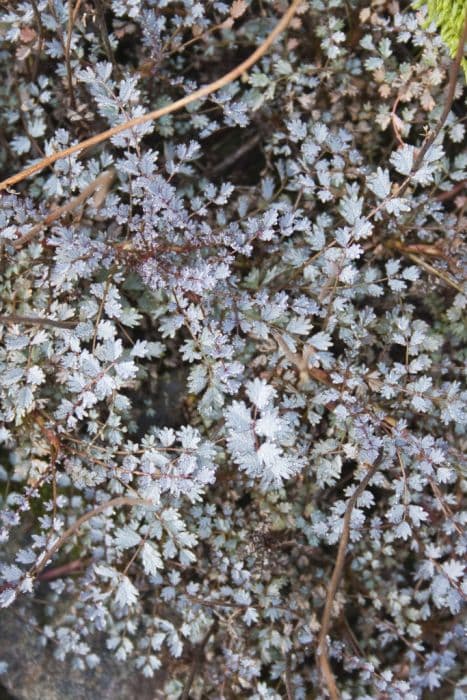Conference Pear Pyrus communis 'Conference' (D)

ABOUT
Pyrus communis 'Conference' is commonly known as the Conference pear. This fruit-bearing plant is distinguished primarily by the pears it produces, which are typically long, narrow, and have a firm texture with a smooth skin that ripens to a green or pale yellow color. The appearance of the pears themselves can be quite distinctive, with some showing a slight russeting on the skin which can give them a slightly rough texture. The plant has a branching structure with twigs and branches that form the canopy where the pears will grow. The leaves of the Conference pear are glossy-green, ovate-shaped, and may have finely toothed edges. The texture of the leaves is somewhat leathery, and they are borne on short stalks. In the spring, the tree is adorned with white flowers that have five petals each and are typically arranged in clusters. These blossoms give way to the fruit, which develops over the growing season and is typically harvested in the fall. The overall appearance of the Conference pear plant is that of a structured and potentially quite lush tree during the growing season, characterized by the attractive contrast between the deep green leaves and the pale, elongated fruits it bears. As a cultivar bred for its fruit, the visual appeal of the Conference pear lies in both its horticultural form and the promise of the edible pears that hang from its branches.
About this plant
 Names
NamesSynonyms
Conference Pear
Common names
Pyrus communis 'Conference'.
 Toxicity
ToxicityTo humans
The common name for Pyrus communis 'Conference' is pear. Pears are not toxic to humans and are commonly consumed as a food source. There are no known toxicity issues with eating pears including their flesh, skin, and juice. However, the seeds contain small amounts of amygdalin, a compound that can release cyanide when metabolized. Ingesting a few seeds is unlikely to cause harm due to the low concentration of amygdalin, but consuming large quantities of crushed or chewed seeds could potentially lead to cyanide poisoning. Symptoms of cyanide poisoning include headache, confusion, nausea, difficulty breathing, and can be life-threatening in severe cases. Nonetheless, such instances are exceptionally rare.
To pets
The common name for Pyrus communis 'Conference' is pear. Pears, specifically the fruit flesh, are generally safe for pets like dogs and cats in moderation. However, similar to humans, the seeds of pears contain small amounts of amygdalin, which can release cyanide when ingested in large quantities. Pets should not be given large amounts of pear seeds; consumption of seeds can lead to the symptoms associated with cyanide poisoning, which include difficulty breathing, panting, shock, and in severe cases could be fatal. It is always recommended to remove the seeds before offering pear to pets.
 Characteristics
CharacteristicsLife cycle
Perennials
Foliage type
Deciduous
Color of leaves
Green
Flower color
White
Height
13 feet (4 meters)
Spread
10 feet (3 meters)
Plant type
Tree
Hardiness zones
5
Native area
Europe
Benefits
 General Benefits
General Benefits- Attractive Aesthetics: Adds visual appeal to gardens with its foliage and form.
- Fruit Production: Bears edible pears that can be consumed fresh or used in cooking.
- Wildlife Habitat: Provides food for birds and other wildlife through its fruit.
- Shade Provider: Offers shade in landscapes due to its canopy as it matures.
- Seasonal Interest: Displays seasonal changes including spring blossoms and autumn leaf color.
- Pollinator Friendly: Attracts bees and other pollinators with its flowers.
 Medical Properties
Medical Properties- This plant is not used for medical purposes.
 Air-purifying Qualities
Air-purifying QualitiesThis plant is not specifically known for air purifying qualities.
 Other Uses
Other Uses- Woodwork: The wood of the Conference pear tree can be used in fine woodworking for items such as musical instruments or intricate carvings due to its fine grain and stability.
- Natural Dyes: Leaves and bark of the pear tree can be used to create natural dyes for fabric, with colors varying depending on the mordants used.
- Photography: In historical photography, the juice of pear trees has been used as a component in developing solutions for certain printing processes.
- Floral Arrangements: The branches of the pear tree can be used in floral arrangements, particularly when they are flowering, to add a rustic or natural touch.
- Gardening: The pruned branches of the pear tree can serve as stakes or supports for other plants in gardening applications.
- Eco-Friendly Packaging: Molded pulp packaging made from pear tree fibers can be a sustainable packaging option for various products.
- Instrument Repair: Pear wood is sometimes used for repairing or restoring woodwind instruments like recorders and clarinets due to its compatibility and similar acoustical properties.
- Smoking Food: Wood chips from the pear tree can be used in smoking meat, imparting a subtle, sweet, and fruity flavor that's less intense than other fruitwoods.
- Insect Hotels: The dense wood and pith of pear branches can be used to create insect hotels for attracting and providing refuge to beneficial garden insects.
- Wood Turning: The pear tree's wood is prized in the craft of woodturning for making decorative objects, due to its smooth finish and workability.
Interesting Facts
 Feng Shui
Feng ShuiThe pear tree is not used in Feng Shui practice.
 Zodiac Sign Compitability
Zodiac Sign CompitabilityThe pear tree is not used in astrology practice.
 Plant Symbolism
Plant Symbolism- Prosperity: Pear trees often symbolize prosperity and good fortune, owing to the fruit's historical association with abundance and valuable harvests.
- Femininity and Fertility: The pear, with its round, curvaceous shape, can be seen as a feminine symbol, representing fertility and sometimes motherhood.
- Longevity and Health: In some cultures, pear trees are associated with long life and health, due to their long-standing role in human nutrition and their hardy nature.
- Peace: Pear trees can represent peace, derived from their gentle appearance and the soothing quality of their green leaves.
- Wisdom: The pear's longstanding presence in human history and its seasonal endurance can also make it emblematic of wisdom and knowledge.
 Water
WaterThe European pear, commonly known as 'Conference', prefers consistent moisture, especially during the growing season. It should be watered deeply once a week, providing about 1-2 gallons of water per session for young trees, and 2-4 gallons for established trees. The actual amount can vary depending on weather conditions and soil type; sandy soils require more frequent watering, while clay soils retain moisture longer. It's important to avoid waterlogging the soil, as this can lead to root rot. During the dormant season, watering can be reduced significantly.
 Light
LightEuropean pear 'Conference' thrives in full sun, which means it requires at least 6 hours of direct sunlight daily. The best spot for this tree is in an open space, away from buildings and shade-providing trees, to ensure it receives ample sunlight throughout the day. Adequate light is crucial for fruit production and overall health of the plant.
 Temperature
TemperatureThe 'Conference' pear variety performs best in a temperate climate. It can tolerate winter temperatures as low as 0°F and is cold hardy up to USDA zone 4. During the growing season, the ideal temperature range is between 65°F and 75°F. Extreme heat above 95°F can stress the plant and requires additional care like mulching and extra watering to help keep the root system cool.
 Pruning
PruningPruning the 'Conference' pear tree is essential for maintaining its shape, removing dead or diseased wood, and encouraging healthy fruit production. Prune the tree during the dormant season, typically late winter or early spring, before new growth starts. Remove any branches that are crossing or growing inward to promote good air circulation. Thinning the fruits in early summer can also help prevent branches from overloading and breaking.
 Cleaning
CleaningAs needed
 Soil
SoilThe best soil mix for Conference Pear (Pyrus communis 'Conference') should be fertile, well-draining, and loamy. It's important to ensure that the soil has a pH between 6.0 and 7.0 for optimal growth. Incorporate organic matter such as compost into the soil to improve its fertility and structure.
 Repotting
RepottingYoung Conference Pear trees (Pyrus communis 'Conference') may need repotting every 2-3 years to ensure enough space for root growth. As they mature, they can be repotted less frequently, as long as they're not root-bound or showing signs of nutrient deficiency.
 Humidity & Misting
Humidity & MistingConference Pear trees (Pyrus communis 'Conference') strive best in outdoor settings, where humidity levels are naturally regulated. They do not require specific humidity levels when grown outside, but they should be protected from excessive moisture to prevent disease.
 Suitable locations
Suitable locationsIndoor
Growing Conference Pear indoors is not advised; they need a garden.
Outdoor
Plant in full sun, well-drained soil, water regularly.
Hardiness zone
4-8 USDA
 Life cycle
Life cyclePyrus communis 'Conference', commonly known as the Conference pear, begins its life as a seed, which under suitable conditions germinates in the soil to establish a root system and shoot. The seedling gradually develops into a sapling and matures over several years into a fruit-bearing tree. During spring, it produces white flowers that are pollinated by insects, leading to the development of pears. The pears ripen by late summer to early autumn, during which time they can be harvested. After fruiting, the tree enters a period of dormancy during the winter months, conserving energy for the next growing season. The Conference pear tree can continue this cycle for many years, often living for several decades and capable of producing fruit for the majority of its lifespan.
 Propogation
PropogationPropogation time
Late winter
The most popular method of propagation for the European Pear 'Conference' variety involves grafting, specifically, bud grafting or chip budding. This method is often carried out in late summer. The process begins with the selection of a healthy and disease-free rootstock, onto which a bud from a desirable 'Conference' pear tree is grafted. A T-shaped cut is made on the rootstock's bark, and a bud, taken from the 'Conference' pear's current year's growth with a small piece of bark attached to it, is inserted into this cut. The bud is then firmly wrapped with budding tape or a rubber band to hold it in place and to ensure good contact with the vascular tissues of the rootstock. The bud will ideally grow into a new branch, eventually becoming part of the mature fruit-bearing tree. This technique allows for the rapid multiplication of true-to-type 'Conference' pear trees while also potentially providing disease resistance or other desirable characteristics from the chosen rootstock.









